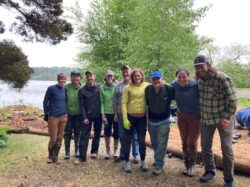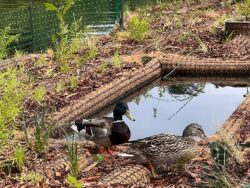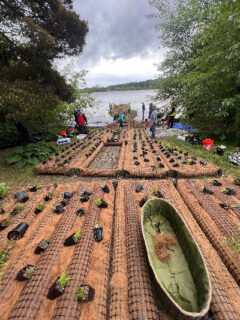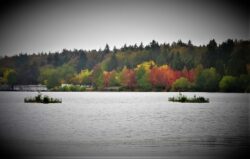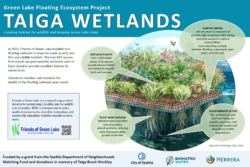by Rob Zisette and Eliza Spear, Herrera Environmental Consultants
Herrera Environmental Consultants has advanced lake science and management and advocated for Washington lakes since the company’s inception over 40 years ago. We believe that an engaged and passionate group of private individuals is crucial to the success of environmental restoration and preservation efforts. We are excited to share (and to have been a part of) the story of bringing floating wetlands to Seattle’s Green Lake to benefit bird and fish habitat and improve water quality.
We first learned about the benefits of constructed floating wetlands 15 years ago when we teamed with Biomatrix Water in Scotland to design a 250-acre “eco corridor” along a severely degraded industrial waterway in Ningbo, China. To complement Herrera’s green stormwater infrastructure design, restoration of the extreme dystrophic conditions required the use of “active island reactors.” These consist of floating wetlands with an engineered treatment system comprised of underwater media columns, aggressive aeration, and a continuous monitoring and process control system incorporated in a high-buoyancy and typhoon-resistant structure. Five years later, the Herrera-Biomatrix team constructed our first floating wetland project in Washington for King County that included two 600 ft2 islands in 4.5-acre Hicklin Lake (see Waterline September 2013).
In 2018, the Friends of Green Lake (FOGL) received a generous donation in memory of Taiga Hinckley and his love of Green Lake, located in the heart of Seattle, Washington. After considering the many needs of this impaired urban lake, FOGL selected a floating wetlands project to cost-effectively restore aquatic habitat and improve water quality. As FOGL president, one of Herrera’s senior limnologists, and a huge proponent of floating wetlands, Rob Zisette assembled a volunteer team of technical experts and interested citizens to design, permit, purchase, plant, install, and maintain Taiga Wetlands to improve native bird habitat, fish habitat, water quality, aesthetic value, and wetland education for Green Lake. Herrera’s wetland scientist Eliza Spear volunteered to obtain the Hydraulic Project Approval permit that FOGL needed to win a $50,000 grant from Seattle’s Department of Neighborhoods. We published a request for proposals and selected Biomatrix Water to provide a total of 40 wetland modules for constructing two 680 ft2 islands. Our specifications included a 10-year warranty, minimum 2.5-ton pull-apart strength and 7.2 lb/ft2 buoyancy, UV-resistant and fully recyclable materials, and no polystyrene, polyurethane, or PVC.
The wetland materials were safely shipped overseas and across the US during the global shipping crisis. They arrived along with components destined for Shilshole Bay for the UW’s Green Futures Lab Sweetwater Project and for a lake in Vancouver, BC. A team of over 30 volunteers, including a dozen current and former Herrera staff, proceeded to assemble, plant, and anchor both islands in one long day on May 30, 2022.
The floating wetlands consist of multiple habitats with standard floating, shallow submerged, open water, and high-buoyancy tree modules that the team planted with 1,086 native plants of 32 different species to create a diverse wetland community. Seattle Parks and Recreation graciously provided storage, transport, traffic control, and gravel for the submerged modules and wood chips for surface mulch. Herrera engineers designed a robust anchoring system that included four 50-foot-long, 3/8-inch steel chains and 50-pound steel anchors per island. The team installed short perimeter fencing to successfully exclude Canada geese and allow passage of small ducks underneath using a Herrera design that has since been incorporated in European systems. Wood duck and tree swallow housings will be installed on the islands in March 2023.
Our project manual includes a long-term monitoring plan to document structure and plant conditions, fish and wildlife use, and water quality benefits. Initial monitoring results show nearly 100 percent survival of the plants, extensive use by native waterfowl, and no vandalism through 2022. Future monitoring will include regular inspection, drone video, and nutrient uptake measurements, and only minor maintenance and repairs are anticipated for at least the next 20 years.
FOGL designed an education sign describing the wetland plant community and habitat structure, and benefits of the plant roots and associated biofilm for invertebrate and fish habitat and adsorbing nutrients to reduce toxic blue-green algae growth in the lake. The sign will be installed at a spot where the thousands of daily users of the Green Lake Park trail have an excellent view of the islands.
To learn more about the Taiga Wetlands project, visit FOGL’s website at https://friendsofgreenlake.org/ and Biomatrix Water’s newsletter and video at https://www.biomatrixwater.com/news/green-lake-seattle-taiga-wetlands/. For more about Herrera’s work protecting lakes and water resources in the Northwest, visit our website at https://www.herrerainc.com/ or contact Rob Zisette at rzisette@herrerainc.com or 206-787-8262.


